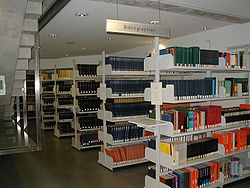Bibliography

Bibliography (from Greek βιβλιογραφία, bibliographia, literally "book writing"), as a practice, is the academic study of books as physical, cultural objects; in this sense, it is also known as bibliology (from Greek -λογία, -logia). On the whole, bibliography is not concerned with the literary content of books, but rather the "bookness" of books.
A bibliography, the product of the practice of bibliography, is a systematic list of books and other works such as journal articles. Bibliographies range from "works cited" lists at the end of books and articles to complete, independent publications. As separate works, they may be in bound volumes such as those shown on the right, or computerised bibliographic databases. A library catalog, while not referred to as a bibliography, is bibliographic in nature. Bibliographical works are almost always considered to be tertiary sources.
Bibliographic works differ in the amount of detail depending on the purpose, and can be generally divided into two categories: enumerative bibliography (also called compilative, reference or systematic), which results in an overview of publications in a particular category, and analytical, or critical, bibliography, which studies the production of books.[1][2] In earlier times, bibliography mostly focused on books. Now, both categories of bibliography cover works in other formats including recordings, motion pictures and videos, graphic objects, databases, CD-ROMs[3] and websites.
Contents |
Etymology
The word bibliographia (βιβλιογραφία) was used by Greek writers in the first three centuries AD to mean the copying of books by hand. In the 12th century, the word started being used for "the intellectual activity of composing books". The 17th century then saw the emergence of the modern meaning, that of description of books.[4]
Enumerative bibliography
A bibliography is a list of writings that share a common factor: this may be a topic, a language, a period, or some other theme. The list may be comprehensive or selective. One particular instance of this is the list of sources used or considered in preparing a work, sometimes called a reference list.
Citation formats vary, but an entry for a book in a bibliography usually contains the following information:
- author(s)
- title
- publisher
- date of publication
An entry for a journal or periodical article usually contains:
- author(s)
- article title
- journal title
- volume
- pages
- date of publication
A bibliography may be arranged by author, topic, or some other scheme. Annotated bibliographies give descriptions about how each source is useful to an author in constructing a paper or argument. These descriptions, usually a few sentences long, provide a summary of the source and describe its relevance. Reference management software may be used to keep track of references and generate bibliographies as required.
Bibliographies differ from library catalogs by including only relevant items rather than all items present in a particular library. However, the catalogs of some national libraries effectively serve as national bibliographies, as the national libraries own almost all their countries' publications.
Analytical bibliography
The critical study of bibliography can be subdivided into descriptive (or physical), historical, and textual bibliography. Descriptive bibliography is the close examination of a book as a physical object, recording its size, format, binding, and so on, while historical bibliography takes a broader view of the context in which a book is produced, in particular, printing, publishing and bookselling. Textual bibliography is another name for textual criticism.
Non-book material
Systematic lists of media other than books can be referred to with terms formed analogously to bibliography:
- Discography — recorded music
- Filmography — films
- Webography (or webliography) — websites (the first use of the word webliography recorded in the Oxford English Dictionary dates from June 1995)
External links
- Oxford Bibliographies Online, in-depth annotated bibliographies by scholars in selected fields
See also
- Citation
- Ibid. / Op cit
- Reference management software / Citation creator
- Reference table
- List of bibliographies
- Library catalog
References
- ↑ Belanger, Terry. "Descriptive Bibliography" Bibliographical Society of America, 2003. Excerpted from Jean Peters, ed., Book Collecting: A Modern Guide (New York and London: R. R. Bowker, 1977), 97-101.
- ↑ Harris, Neil. Analytical bibliography: an alternative prospectus. Chapter 1. Definitions of bibliography, and in particular of the variety called analytical. Institut d'histoire du livre, 2004.
- ↑ Harmon, Robert B. Elements of bibliography: a simplified approach. Rev. ed. Metuchen, N.J.: Scarecrow Press, 1989. p. 4. ISBN 0810822180.
- ↑ Blum, Rudolf. Bibliographia, an inquiry into its definition and designations. Translated by Mathilde V. Rovelstad. Chicago, Ill.: American Library Association ; Folkestone, Kent, England: Dawson, 1980. p. 12. ISBN 0838901468.